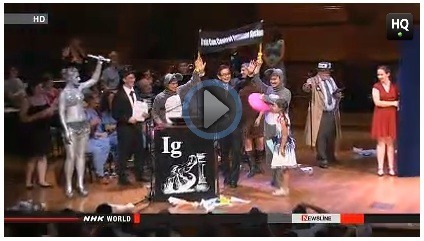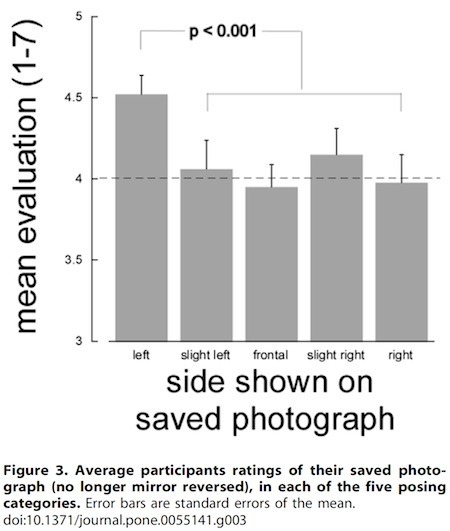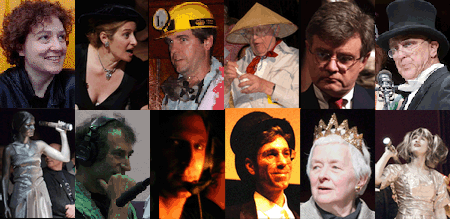Marc Abrahams's Blog, page 464
September 14, 2013
A new pope, a new look at sacerdotal celibacy
The Catholic Church recently gave itself a new pope. On the question of priests engaging in sexual reproduction, history is repeating itself. The last time around, we wrote (in 2005), in The Guardian:
Whenever there is a new pope, the air fills with questions about priestly celibacy. The more formal term for this practice is “sacerdotal celibacy”. The most popular piece of literature on the topic, Henry Charles Lea’s voluminous History of Sacerdotal Celibacy was published in 1867 and has enjoyed many, many reprints. The book is 600 pages of juicy history and gossip, collected and described by a man who truly loved thinking about sacerdotal celibacy.…
Now, in 2013, NBC News reports:
The Vatican’s new secretary of state has said that priestly celibacy is not church dogma and therefore open to discussion, marking a significant change in approach towards one of the thorniest issues facing the Roman Catholic Church….
Video of the interview (in Spanish) is online courtesy of the Venezuelan newspaper El Universal.

The Ig Informal Lectures at MIT — Today!
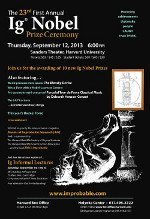 The Ig Informal Lectures happen today.
The Ig Informal Lectures happen today.
WHEN: Saturday, September 14, at 1:00 pm.
WHERE: MIT, building 26, room 100.
It’s free. No tickets needed — but seating is limited, so if you want a seat, get there early.
The new Ig Nobel Prize winners will explain, as best they can, what they did and why they did it. The winners will be available for you to talk with, both before and after the lectures.
This free event is organized in cooperation with the MIT Press Bookstore.
Also at this event: The MIT community will celebrate the work of George Blonsky—a 1925 graduate of MIT!—and his wife, Charlotte. The Blonskys were awarded an Ig Nobel Prize, in 1999, for their invention (US patent #3216423, “APPARATUS FOR FACILITATING THE BIRTH OF A CHILD BY CENTRIFUGAL FORCE“). The new opera about the Blonskys and their work premiered on September 12, as part of the Ig Nobel Prize Ceremony.

September 13, 2013
A glimpse of Japanese Ig Nobel reportage
Among the many press accounts and reactions to the 2013 Ig Nobel Prize ceremony is this one by NHK, the Japanese public TV network, in Japanese, and in English:
As the NHK report points out, Japan has long been a leading producer of Ig Nobel Prize winners.
Fuji TV also came to the ceremony, and broadcast a report.
BONUS: Some of the other Japanese media reports

September 12, 2013
Announcing: The 2013 Ig Nobel Prize winners
 The 2013 Ig Nobel Prize winners were announced and introduced tonight (Thursday, September 12) at the 23rd First Annual Ig Nobel Prize ceremony, at Harvard University.
The 2013 Ig Nobel Prize winners were announced and introduced tonight (Thursday, September 12) at the 23rd First Annual Ig Nobel Prize ceremony, at Harvard University.
On Saturday afternoon (September 12), many of the new winners will give short public talks at the Ig Informal Lectures. They will explain, as best they can, what they did and why they did it. The Ig Informal Lectures happen at MIT, Saturday, at 1:00 pm. You are invited. It’s free.

Ig Nobel Prize ceremony and webcast TONIGHT
 The 23rd First Annual Ig Nobel Prize ceremony happens tonight, Thursday, September 12, 2013, at Harvard University. (Tickets are sold out.)
The 23rd First Annual Ig Nobel Prize ceremony happens tonight, Thursday, September 12, 2013, at Harvard University. (Tickets are sold out.)
Webcast of the Ceremony
The ceremony will be webcast live here on the improbable web site, at www.improbable.com/ig/2013/
Schedule:
5:35 pm (US eastern time) — The webcast begins.
5:40 pm — Deborah Henson-Conant’s pre-ceremony mini-concert.
6:00 pm — The ceremony begins.
The webcast will also appear be available on other web sites. Here are some of them:
The Guardian, Slate, QI, Neatorama, Io9, Boston Globe, Chemical & Engineering News, LiveScience, Institute for Engineering, Huffington Post, Medpage, Fox News, Gazeta Wyborcza, Tiede, ABC, Australian Geographic, Nature, Popular Science, Dagens Nyheter
Tweeting: Lots of tweeting’s expected, with hashtag #IgNobel
Also: The NSA Courtesy Cam
This year we will also be sending out a second, parallel live webcast, the NSA Courtesy Cam, offered to the NSA, MI5, and the world’s other security agencies as a courtesy. It will show a behind-the-scene view of the ceremony. You can access that feed at http://www.youtube.com/watch?v=zeNdy_gsfE8
Parties
Webcast-watching parties are happening in Paris, Atlanta, Raleigh, and other places. (And two days from now, on Saturday night, there’s a big event in Leiden)
(And on Saturday: The Ig Informal Lectures)
Two days after the ceremony, on Saturday afternoon, Sept 14, The Ig Informal Lectures happen, at MIT. Please come be part of that!

September 11, 2013
Side-bias in Smartphone Selfies
This study reveals that smartphone self-portraits may perhaps reveal something about left and right, maybe:
“Self-Portraits: Smartphones Reveal a Side Bias in Non-Artists,” Nicola Bruno [pictured here, and who also recently did a study on an effect of red] and Marco Bertamini, PLoS ONE, 8(2), 2013, e55141. The authors, at the Universita di Parma, Italy and the University of Liverpool, UK, explain:
“According to surveys of art books and exhibitions, artists prefer poses showing the left side of the face when composing a portrait and the right side when composing a self-portrait. However, it is presently not known whether similar biases can be observed in individuals that lack formal artistic training. We collected self-portraits by naı¨ve photographers who used the iPhoneTM front camera, and confirmed a right side bias in this non-artist sample and even when biomechanical constraints would have favored the opposite. This result undermines explanations based on posing conventions due to artistic training or biomechanical factors, and is consistent with the hypothesis that side biases in portraiture and self-portraiture are caused by biologically- determined asymmetries in facial expressiveness.”
Here’s a detail from the study:

Who’s who at the 2013 Ig Nobel Prize Ceremony
The biggest stars at the 23rd First Annual Ig Nobel Prize ceremony Thursday night will be the 2013 Ig Nobel Prize winners, come from 18 nations on five continents. Their identity is secret until each of them is introduced at the ceremony.
Nobel laureates Dudley Herschbach (chemistry, 1986), Eric Maskin (economics, 2007), Roy Glauber (physics, 2005), and Frank Wilczek (physics, 2004) will present the prizes to the Ig Nobel Prize winners.
The ceremony will also star this year’s 24/7 LECTURERS, each of whom will explain her or his subject first in TWENTY-FOUR (24) SECONDS, and then in SEVEN (7) WORDS:
Dudley Herschbach (Nobel Laureate, Chemistry). Topic: TORQUE
Xiao-Li Meng (Dean of the Graduate School, Harvard). Topic: STATISTICS
Melissa Franklin (Professor of Physics, Harvard). Topic: FORCE
The new mini-opera, The Blonsky Device, directed, arranged and orchestrated by Henry Akona, stars Maria Ferrante (soprano), Martin Kelly (tenor), Philip Lima (baritone), and Miles Rind, (bass), backed by an all-star biomedical orchestra, “The Forces of Nature”, composed of Harvard and MIT physicians and researchers assembled by Dr. Thomas Michel.
And that’s just the beginning. Click on the image below to see pretty much everyone else:
The gang includes these two lookalikes:

Karaoke Reversal: A technical approach
Daisuke Inoue of Hyogo, Japan, was awarded the 2004 Ig Nobel peace prize for inventing karaoke, thereby providing an entirely new way for people to learn to tolerate each other. For the very few of our readers who might not know what karaoke is – we offer this description :
‘It’s a form of interactive entertainment in which amateur singers sing along with well known popular music recordings which have been re-recorded (or remixed) in the form of a backing track, i.e. with the original vocal tracks removed.’
 But what are the options if you’re after the opposite – a standalone vocal track with the backing track removed? Creating, in other words, what might be called a ‘Reverse Karaoke’ recording? Without access to the original multitrack master, removing everything except the vocals can sometimes be a surprisingly difficult job – one which has caught the attention of researchers of the Audio Research Group at the Dublin Institute of Technology, where researcher Dr. Derry FitzGerald Ph.D., M.A., B.Eng.has developed a Digital Signal Processing (DSP) technique to perform just such a task. Details are presented as part of the Proceedings of the 16th International Conference on Digital Audio Effects (DAFx-13), Maynooth, Ireland, September 2-4, 2013. see: STEREO VOCAL EXTRACTION USING ADRESS AND NEAREST NEIGHBOURS MEDIAN FILTERING [their caps, & ADRESS is the correct spelling]
But what are the options if you’re after the opposite – a standalone vocal track with the backing track removed? Creating, in other words, what might be called a ‘Reverse Karaoke’ recording? Without access to the original multitrack master, removing everything except the vocals can sometimes be a surprisingly difficult job – one which has caught the attention of researchers of the Audio Research Group at the Dublin Institute of Technology, where researcher Dr. Derry FitzGerald Ph.D., M.A., B.Eng.has developed a Digital Signal Processing (DSP) technique to perform just such a task. Details are presented as part of the Proceedings of the 16th International Conference on Digital Audio Effects (DAFx-13), Maynooth, Ireland, September 2-4, 2013. see: STEREO VOCAL EXTRACTION USING ADRESS AND NEAREST NEIGHBOURS MEDIAN FILTERING [their caps, & ADRESS is the correct spelling]
Dr. FitzGerald also provides online access to audio results of the system’s performance (.mp3 format) – for example :
‘Knowing me Knowing You’ (ABBA) – original.
‘Knowing me Knowing You’ (ABBA) – backing removed.
there’s more here :
NOTE: Other research groups worldwide are pursuing the Reverse Karaoke goal : e.g. • University of Hertfordshire, UK, • University of California, US, • Northwestern University, US, • IRCAM, Paris, France, • Electronics and Telecommunications Research Institute (ETRI), Daejeon, Korea, and many, many more.
ALSO of NOTE:
• Info on the OOPS technique – a comparatively crude but often highly effective analog technique with similar aims.
• Un-karaoke or de-karaoke : Improbable is aware of only one documented account of Un-karaoke or de-karaoke – whereby a renowned pop-artist performs a live vocal on a karaoke track of one of their own famous songs – as did the late Robert Palmer when he rendered ‘Addicted to Love’ at a karaoke club in London’s SoHo.

September 9, 2013
Quoth the philosopher: About the Loop Case
Philosopher S. Matthew Liao writes, in his blog:
…Our research applies this experimental philosophical methodology to Judith Jarvis Thomson’s famous Loop Case, which she used to call into question the validity of the intuitively plausible Doctrine of Double Effect. We found that intuitions about the Loop Case vary according to the context in which the case is considered. We contend that this undermines the supposed evidential status of intuitions about the Loop Case.
That and other details are in the study
“Putting the Trolley in Order: Experimental Philosophy and the
Loop Case,” S. Matthew Liao (NYU), Alex Wiegmann (Göttingen), Joshua Alexander (Sienna), and Gerard Vong (Fordham), Forthcoming in Philosophical Psychology, epub June 5, 2011.

Paper aeroplane ‘aerogami’ drones (paper)
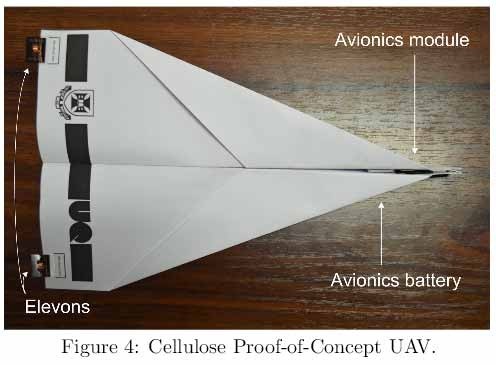 Could “Disposable Folded Cellulose-Substrate Micro-Unmanned Aerial Vehicles” – known to some as paper aeroplanes – be used as disposable, biodegradable monitoring-and-surveillance drones?
Could “Disposable Folded Cellulose-Substrate Micro-Unmanned Aerial Vehicles” – known to some as paper aeroplanes – be used as disposable, biodegradable monitoring-and-surveillance drones?
A report presented at the Australasian Conference on Robotics and Automation, 3-5 Dec 2012, suggests just that. Researcher Dr. Paul Pounds, at the University of Queensland Australia, explains in his paper : ‘Paper Plane: Towards Disposable Low-Cost Folded Cellulose-Substrate UAVs’
“Disposable folded cellulose-substrate micro-Unmanned Aerial Vehicles (UAVs) (paper planes) have the surprising potential to be effective platforms for deploying remote sensors at low-cost.“
A proof-of-concept “aerogami” prototype was constructed using University of Queensland A4 notepaper [pictured above]. If taken into production, the idea would be to deploy the DLCFCSUAVs in large numbers from aircraft or balloons – but in this case the prototypes were tested by launching them across the lab with an elastic catapult. Reaching glide distances of up to 5 metres (unladen) and 4 metres (laden).
In conclusion :
“A simple disposable MAV platform has been developed, based on the venerable paper plane design. The aircraft was capable of stable gliding flight, and is equipped with small onboard voice-coil actuators and onboard 6-DOF inertial measurement for motion control. The proof-of-concept system demonstrated stable gliding flight, and it was shown that the addition of avionic control systems did not compromise gliding performance. Ongoing work aims to regulate aircraft velocity under feedback control, and eventually allow aircraft released at high-altitude to navigate long distances autonomously, with no further input of energy.”
BONUS: The paper provides a free cut-out-and-keep template for you to construct a fully working prototype. [page 9] [battery and electronics not included]
NOTE: Deployment of disposable folded cellulose-substrate micro-unmanned aerial vehicles (paper planes) is a tradition at the Ig Nobel Prize Ceremonies.

Marc Abrahams's Blog
- Marc Abrahams's profile
- 14 followers



